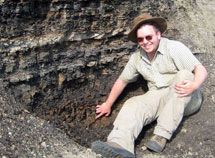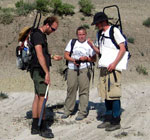 |
|||||
| Biology Home Page | News | Calendar | Make a Gift | |||||
|
Fall 2008 | Return to issue home
Investigating the K-T Boundary By Kristy Brady
Extinction is not a rare event. In fact, the majority of all species that have ever existed on Earth are now extinct. In the roughly 3.5 billion years that there has been life on Earth, there have been five mass extinctions, relatively short periods of time in which droves of species went extinct. The largest of these was the Permian-Triassic mass extinction about 250 million years ago. The most recent was the Cretaceous-Tertiary mass extinction 65 million years ago. The Cretaceous-Tertiary, or K-T, mass extinction is famous for wiping out the dinosaurs. Despite its reputation, extinction is not necessarily a bad thing. Consider this: without extinction, humans may never have evolved. Each mass extinction event has opened up previously occupied niches, or roles in the community, meaning they created the opportunity for new species to evolve. “In this way, mass extinctions have overwhelmingly shaped the trajectories evolution has taken,” Biology assistant professor Greg Wilson explains. Greg is researching how the K-T mass extinction affectted the evolution of mammals. Prior to the K-T extinction, there were relatively few mammal species. Afterward, however, the family tree of mammals expanded spectacularly, leading ultimately to what exists today. By looking at tooth morphology, Greg is piecing together the initial rate and pattern of mammal expansion following the K-T mass extinction. Tooth morphology provides an astonishing amount of information both directly and indirectly. For example, whether the animal was an herbivore, omnivore, or carnivore can be inferred by looking at teeth. Subsequently, the presence of whatever the mammal was feeding on, say, grass, can be presumed.* When I met Greg, he was preparing to leave for his summer field season at Hell Creek, Montana. In 1902 researchers discovered the first Tyrannosaurus rex at Hell Creek. It is also where Triceratops, duck-billed dinosaurs, and a host of other dinosaur species were unearthed for the first time. Exposed stratified rocks make Hell Creek ideal for fossil hunting. Over time, erosion has effectively opened a window into the past allowing researchers to use the rock layers as a virtual clock. The K-T boundary is nicely framed there, which permits Greg to look at species that existed before and after the K-T boundary.
Determining what exactly triggered a mass extinction can be tricky. The K-T extinction is thought to have been caused by an asteroid colliding with Earth; the timing of the two events is extremely close. Yet the asteroid collision may have acted to exacerbate conditions that were already leading to widespread extinction. For instance, volcanism was rampant during the K-T transition and volcanic eruptions spew noxious gases into the atmosphere, which can generate acid rain. And extreme volcanic activity can severely diminish the amount of daylight reaching the Earth’s surface thus arresting photosynthesis and primary production. So Greg and several colleagues are looking for evidence that suggests species either started going extinct prior to the asteroid collision or following it. Such evidence includes changes in the number of species through time and changes in the relative abundances of those species. To date, Greg says they have not identified a clear, consistent pattern across the K-T boundary of what survived and what perished. For example, the K-T mass extinction completely extinguished non-avian dinosaurs. Yet at Hell Creek the same amphibian species existed before and after the K-T boundary. Today we consider amphibian species canaries in the mine, beacons informing us of an increasingly polluted and inhospitable environment, species that would not likely survive the extreme conditions created by either raging volcanic activity or an asteroid collision. In addition to Montana, Greg has spent time collecting fossils in Colorado, Baja, India, and Africa. The pattern of evolution on southern continents appears to be significantly different than the pattern on northern continents. But logistically, Greg explained, it is much more difficult to study on southern continents – imagine transporting all the water you need for several weeks into an African desert. Because access to many southern sites is difficult, not much research has been done there. What this likely means is that down south there are scores of fossils lying in wait of discovery, many of which will be of previously unknown species. For more information on Greg Wilson’s research, visit his Web site. *See the article on Caroline Strömberg’s research for a related story.
Fall 2008 | Return to issue home | |||||
|
|||||


